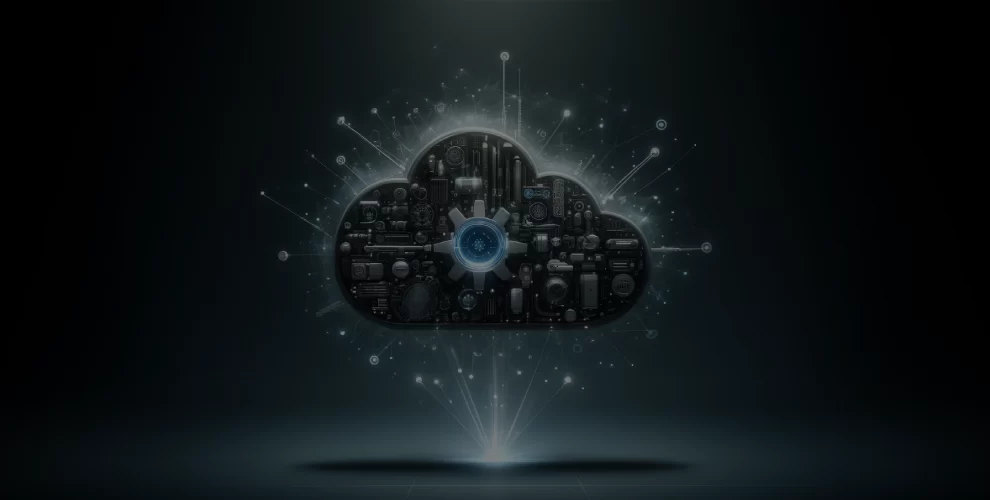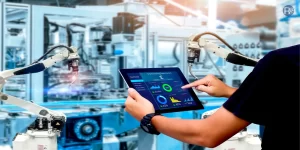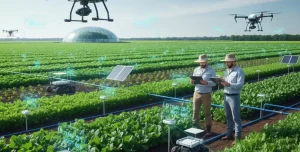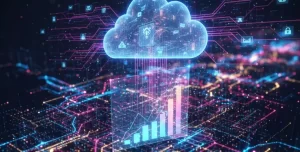
The Rise of Industrial IoT: Benefits and Challenges
Table of Contents
Introduction
Welcome to WikiGlitz! The Industrial Internet of Things (IIoT) is transforming industries by integrating smart technologies, connectivity, and data analytics to optimize processes and enhance productivity.
In this article, we’ll explore the benefits and challenges of IIoT, providing a comprehensive guide to understanding its impact on manufacturing and beyond.
Key Takeaways
- Enhanced Operational Efficiency: IIoT streamlines processes and reduces inefficiencies.
- Predictive Maintenance: Real-time monitoring and maintenance reduce downtime.
- Data-Driven Decision-Making: Analytics and machine learning provide actionable insights.
What is Industrial IoT (IIoT)?
The Industrial Internet of Things (IIoT) refers to the network of interconnected devices, sensors, machines, and systems that communicate and share data in real time.
Unlike consumer IoT, which focuses on convenience for individual users, IIoT aims to improve the efficiency, safety, and productivity of industrial operations.
IIoT systems, often referred to as cyber-physical systems, interface the digital world with the physical world through sensors and actuators.
These systems gather data, analyze it, and make informed decisions to optimize industrial processes.
Key Components of IIoT:
- Sensors and Actuators: Devices that collect data and perform actions based on that data.
- Connectivity: Networks that enable devices to communicate with each other and central systems.
- Data Analytics: Tools and algorithms that process and analyze collected data.
- User Interfaces: Platforms that allow users to interact with the IIoT system and make informed decisions.
Benefits of Industrial IoT
Enhanced Operational Efficiency
IIoT significantly enhances operational efficiency by providing real-time monitoring of equipment and production lines. Connected devices within manufacturing plants create smart factories that leverage sensors and embedded systems to monitor and control various processes.
This seamless flow of information improves efficiency by automating routine tasks, optimizing resource utilization, and minimizing downtime through predictive maintenance.
Examples:
- Smart Factories: Facilities where sensors monitor equipment performance and production processes, enabling proactive maintenance and optimizing workflows.
- Resource Optimization: Real-time data helps identify inefficiencies and bottlenecks, allowing for immediate corrective actions.
Predictive Maintenance
By continuously monitoring the health and performance of equipment, IIoT systems can predict potential issues before they escalate.
This proactive approach reduces maintenance costs, extends the lifespan of machinery, and minimizes production disruptions.
Examples:
- Reduced Downtime: Predictive maintenance helps schedule repairs before equipment failure, avoiding unexpected breakdowns.
- Cost Savings: Early detection of issues reduces the need for extensive repairs and extends machinery lifespan.
Data-Driven Decision-Making
Advanced analytics and machine learning algorithms process this data to provide valuable insights into production trends, demand forecasting, and supply chain optimization.
Examples:
- Production Trends: Analyzing data to identify trends and optimize production schedules.
- Supply Chain Optimization: Using data to forecast demand and manage inventory more effectively.
Smart Metering and Energy Management
Smart metering and energy management are significant benefits of IIoT, helping industries monitor and manage resource consumption efficiently.
IoT sensors can track the use of electricity, water, and fuels, providing real-time data on consumption patterns. This information allows for better management of resources, leading to significant cost savings and reduced environmental impact.
Examples:
- Smart Meters: Devices that measure and report the consumption of resources like electricity and water, enabling better management and conservation.
- Energy Optimization: Data from smart meters helps industries optimize energy use and reduce wastage.
Enhanced Industrial Safety
IIoT plays a crucial role in enhancing industrial safety by continuously monitoring key performance indicators of health and safety. IoT devices can track environmental conditions, equipment status, and worker safety metrics, providing real-time alerts for potential hazards.
Examples:
- Real-Time Monitoring: Sensors that monitor air quality, temperature, and other environmental factors to ensure safe working conditions.
- Safety Alerts: Immediate notifications for abnormal conditions or potential hazards, enabling quick response and prevention of accidents.
Challenges of Industrial IoT
Security Vulnerabilities
Security is a significant concern in IIoT due to the interconnected nature of devices and systems. The automatic communication between IoT devices can create new security challenges, such as unauthorized access and data breaches.
Ensuring robust encryption, secure authentication, and regular updates are essential to protecting IIoT systems.
Challenges:
- Data Breaches: Unauthorized access to sensitive data.
- Network Security: Ensuring secure communication between devices.
Solutions:
- Encryption: Implementing strong encryption protocols to protect data.
- Authentication: Using secure authentication methods to verify user and device identities.
Interoperability Issues
Interoperability is another challenge in IIoT, as devices from different manufacturers often use various communication protocols and standards.
This lack of standardization can hinder the seamless integration of devices, affecting the efficiency and effectiveness of IIoT systems.
Challenges:
- Compatibility: Devices using different protocols may not communicate effectively.
- Integration: Difficulty in integrating new devices into existing systems.
Solutions:
- Standardization: Developing and adopting common standards and protocols.
- Middleware Solutions: Using middleware to facilitate communication between different devices and systems.
High Implementation Costs
The initial investment required for implementing IIoT solutions can be substantial, including costs for new devices, infrastructure, and training.
Many companies are hesitant to adopt IIoT due to concerns about the return on investment and the complexity of deployment.
Challenges:
- Cost: High initial investment for IIoT infrastructure.
- ROI Concerns: Uncertainty about the long-term benefits and returns.
Solutions:
- Scalable Solutions: Implementing IIoT in phases to spread out costs.
- Cost-Benefit Analysis: Conducting thorough analyses to demonstrate potential savings and efficiency gains.
Case Studies
Manufacturing
Example: General Electric General Electric (GE) has implemented IIoT solutions in their manufacturing plants to create smart factories.
By using IoT sensors and data analytics, GE monitors equipment performance and predicts maintenance needs, reducing downtime and increasing efficiency.
Benefits:
- Higher Efficiency: Helps in optimizing production.
- Lesser Downtime: Prevents issues earlier.
Agriculture
Example: John Deere John Deere, a leading manufacturer of agricultural machinery, has integrated IIoT technology into their equipment to support precision farming.
Their IoT-enabled tractors and harvesters collect data on soil conditions, crop health, and machinery performance, helping farmers make data-driven decisions.
Benefits:
- Improved Crop Yields: Data-driven decisions enhance crop management.
- Resource Management: Efficient use of water, fertilizers, and other resources.
Healthcare
Example: Remote Patient Monitoring Healthcare providers are using IIoT for remote patient monitoring. Wearable devices and smart medical equipment collect real-time health data, which is transmitted to healthcare providers.
Benefits:
- Enhanced Patient Care: Continuous monitoring provides real-time insights into patient health.
- Reduced Hospital Readmissions: Early detection and intervention prevent complications.
Future Trends in Industrial IoT
Integration of 5G Connectivity
The integration of 5G technology is set to revolutionize IIoT by providing faster and more reliable connections for IoT devices.
5G networks offer lower latency, higher bandwidth, and the ability to connect a massive number of devices simultaneously. This will enhance real-time data processing, communication, and overall system performance, enabling more sophisticated IIoT applications.
Examples:
- Real-Time Data Processing: Improved speed and reliability for data-intensive applications.
- Enhanced Connectivity: Seamless communication between a large number of IoT devices.
Advancements in AI and Machine Learning
Artificial intelligence (AI) and machine learning (ML) are transforming IIoT by enabling more advanced data analytics and automation.
AI algorithms can analyze vast amounts of data generated by IoT devices to identify patterns, predict outcomes, and optimize processes. This will lead to smarter decision-making, increased efficiency, and the development of new applications.
Examples:
- Predictive Analytics: Using AI to predict maintenance needs and prevent equipment failures.
- Process Optimization: AI-driven insights to enhance production efficiency and reduce waste.
Edge Computing
Edge computing brings data processing closer to the source of data generation, reducing latency and bandwidth usage.
By processing data at the edge of the network, IIoT systems can respond more quickly to real-time events and operate more efficiently. This is particularly beneficial for applications that require immediate action, such as predictive maintenance and industrial automation.
Examples:
- Reduced Latency: Faster response times for critical applications.
- Bandwidth Efficiency: Minimizing the amount of data transmitted to central servers.
Conclusion
The Industrial Internet of Things (IIoT) is reshaping various industries by enhancing operational efficiency, enabling predictive maintenance, and supporting data-driven decision-making.
Despite challenges such as security vulnerabilities, interoperability issues, and high implementation costs, the benefits of IIoT are significant.
As technology continues to advance, with developments in 5G, AI, and edge computing, IIoT will play an increasingly vital role in driving innovation and efficiency in manufacturing and beyond.
Stay tuned to WikiGlitz for more insights and updates on the latest technology trends. We hope you found this guide informative and helpful in understanding the rise of Industrial IoT.
FAQs
What is Industrial IoT (IIoT)?
The Industrial Internet of Things (IIoT) refers to the network of interconnected devices, sensors, machines, and systems that communicate and share data in real time to improve industrial efficiency, safety, and productivity.
How does IIoT improve operational efficiency?
IIoT enhances operational efficiency by providing real-time monitoring, automating routine tasks, optimizing resource utilization, and enabling predictive maintenance to prevent equipment failures and reduce downtime.
What are the main challenges of implementing IIoT?
Key challenges include security vulnerabilities, interoperability issues, high implementation costs, and data privacy concerns. Addressing these challenges requires robust encryption, secure authentication, standardization, and cost-benefit analysis.
How does predictive maintenance benefit industries?
Predictive maintenance uses real-time data to anticipate equipment failures, allowing for timely repairs and maintenance.
What are the future trends in Industrial IoT?
Future trends include the integration of 5G connectivity for faster and more reliable data processing, advancements in AI and machine learning for smarter analytics and automation, and the adoption of edge computing for reduced latency and increased efficiency.
Want to keep up with our blog?
Our most valuable tips right inside your inbox, once per month.
Error: Contact form not found.
WikiGlitz Team
Welcome to WikiGlitz, your ultimate destination for tech insights and innovation. Our expert team is dedicated to delivering free resources and professional advice on various technology topics, including Artificial Intelligence, Cyber Security, Cloud Computing, and more. We strive to empower our readers with up-to-date information and practical guidance, ensuring you stay ahead in the rapidly evolving tech landscape. At WikiGlitz, we are passionate about making complex technology accessible to everyone. Our team of seasoned experts curates content that is both informative and engaging, helping you understand and leverage the latest tech trends. Whether you're a tech enthusiast or a professional, WikiGlitz is your go-to source for reliable, expert-driven content. Join us on this journey to explore and embrace the future of technology.





